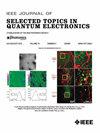用于自由空间光通信上行链路的大功率光纤激光器
IF 5.1
2区 工程技术
Q1 ENGINEERING, ELECTRICAL & ELECTRONIC
IEEE Journal of Selected Topics in Quantum Electronics
Pub Date : 2025-07-18
DOI:10.1109/JSTQE.2025.3590645
引用次数: 0
摘要
在使用自由空间光通信的日益增长的卫星网络中,地面到卫星的光上行链路是基础设施的关键部分。由于大气中的散射、吸收和湍流对自由空间光束造成畸变,对上行链路的光功率要求高于系统的其他部分。由于光纤激光器具有鲁棒性、高平均功率、优异的光束质量和高效率,因此有望成为上行发射机的关键部件。本文将简要概述光地面站的考虑因素,并对自由空间光通信系统的潜在光纤激光源进行综述。详细的结果将在一个非常大的模式面积掺铒光纤放大器,核心泵浦的1480 nm拉曼光纤激光器,能够工作在100 W的平均功率。给出了系统在工作功率高达90w时的误码率测试结果。本文章由计算机程序翻译,如有差异,请以英文原文为准。
High-Power Fiber Lasers for Free-Space Optical Communication Uplinks
Ground to satellite optical uplinks are a critical part of the infrastructure in the growing satellite network using free-space optical communications. Because of distortions to the free space optical beam caused by scattering, absorption and turbulence in the atmosphere, the optical power requirements for the uplink are higher than other parts of the system. Fiber lasers are expected to be a key component in the uplink transmitter, due to their robust nature, ability to operate at high average power with excellent beam quality, and high efficiency. This work will provide a brief overview of considerations for optical ground stations, and review of potential fiber laser sources for free space optical communications systems. Detailed results will be presented on a very-large mode area Er-doped fiber amplifier, core pumped by a 1480 nm Raman fiber laser, capable of operating at 100 W average power. Bit error rate testing results for the system at operating powers of up to 90 W will be presented.
求助全文
通过发布文献求助,成功后即可免费获取论文全文。
去求助
来源期刊

IEEE Journal of Selected Topics in Quantum Electronics
工程技术-工程:电子与电气
CiteScore
10.60
自引率
2.00%
发文量
212
审稿时长
3 months
期刊介绍:
Papers published in the IEEE Journal of Selected Topics in Quantum Electronics fall within the broad field of science and technology of quantum electronics of a device, subsystem, or system-oriented nature. Each issue is devoted to a specific topic within this broad spectrum. Announcements of the topical areas planned for future issues, along with deadlines for receipt of manuscripts, are published in this Journal and in the IEEE Journal of Quantum Electronics. Generally, the scope of manuscripts appropriate to this Journal is the same as that for the IEEE Journal of Quantum Electronics. Manuscripts are published that report original theoretical and/or experimental research results that advance the scientific and technological base of quantum electronics devices, systems, or applications. The Journal is dedicated toward publishing research results that advance the state of the art or add to the understanding of the generation, amplification, modulation, detection, waveguiding, or propagation characteristics of coherent electromagnetic radiation having sub-millimeter and shorter wavelengths. In order to be suitable for publication in this Journal, the content of manuscripts concerned with subject-related research must have a potential impact on advancing the technological base of quantum electronic devices, systems, and/or applications. Potential authors of subject-related research have the responsibility of pointing out this potential impact. System-oriented manuscripts must be concerned with systems that perform a function previously unavailable or that outperform previously established systems that did not use quantum electronic components or concepts. Tutorial and review papers are by invitation only.
 求助内容:
求助内容: 应助结果提醒方式:
应助结果提醒方式:


